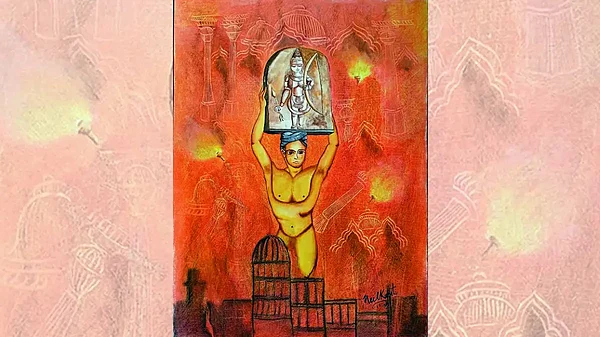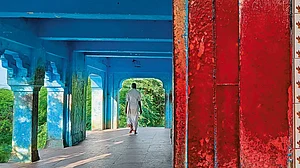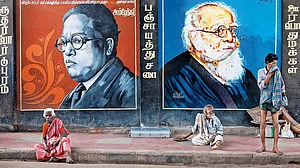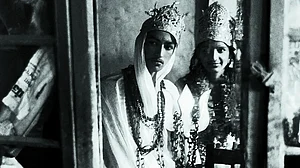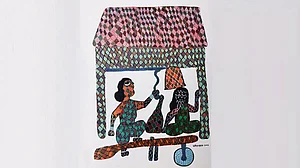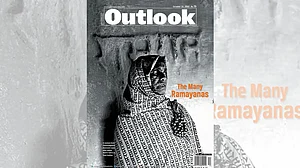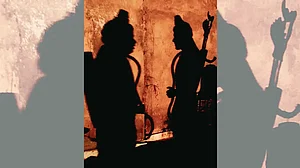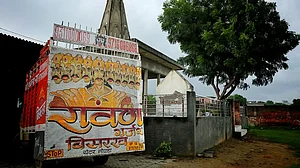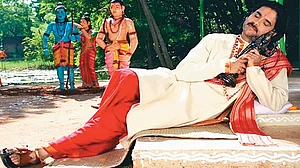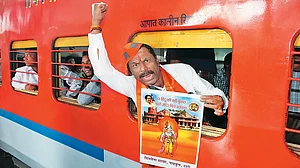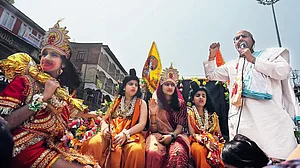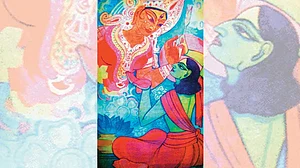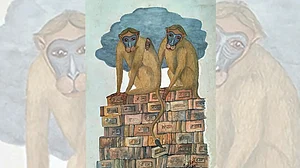If Tulsidas made Ram a self-effacing family man and king to be worshipped, the Ayodhya movement lent him a political identity. Tulsidas’s Ram was a stoic and gentle being. L.K. Advani’s Ram is an electoral warrior.
- COVER STORY
The bestselling author and his producer-director recall their travels through Chitrakoot, shooting for a TV show on the Ram Van Gaman trail
The epic of Ramayan whose multiple renditions are known for the proverbial and more obvious battle of good versus evil also contains embedded narratives about the importance of ecology
Both Periyar and Ambedkar looked at the Ramayana as a story that perpetuated the subjugation of non-Aryans and Dalits
Until a few years ago, the elders of Mithila refrained from even drinking water in Ayodhya, because nobody eats or drinks at the daughter’s sasural.
Outlook asked people across India who Ram is and what the Ramayana means to them. Here is what we found.
Adivasis in Jharkhand contest the view that Ram worship has a long history in the tribal dominated state
Ram Navami And Dussehra in Northeast: In many tribal versions, certain characters and events of the Valmiki Ramayana change according to the culture, tradition, ecology and the animistic faiths. Hence, they become more of a cultural metaphor than sacred texts.
Ramayana is a story of struggle against society’s imposed morality, of kings and queens who are products of their circumstances and choices. This Diwali, Outlook looks back at its 2022 magazine issue titled 'The Many Ramayanas'.
Millions, who may not agree with Ram’s ideals, engage with his story, which calls upon them to confront their own behaviour
The bestselling author and his producer-director recall their travels through Chitrakoot, shooting for a TV show on the Ram Van Gaman trail
The epic of Ramayan whose multiple renditions are known for the proverbial and more obvious battle of good versus evil also contains embedded narratives about the importance of ecology
Both Periyar and Ambedkar looked at the Ramayana as a story that perpetuated the subjugation of non-Aryans and Dalits
Until a few years ago, the elders of Mithila refrained from even drinking water in Ayodhya, because nobody eats or drinks at the daughter’s sasural.
Outlook asked people across India who Ram is and what the Ramayana means to them. Here is what we found.
Adivasis in Jharkhand contest the view that Ram worship has a long history in the tribal dominated state
Ram Navami And Dussehra in Northeast: In many tribal versions, certain characters and events of the Valmiki Ramayana change according to the culture, tradition, ecology and the animistic faiths. Hence, they become more of a cultural metaphor than sacred texts.
Ramayana is a story of struggle against society’s imposed morality, of kings and queens who are products of their circumstances and choices. This Diwali, Outlook looks back at its 2022 magazine issue titled 'The Many Ramayanas'.
Millions, who may not agree with Ram’s ideals, engage with his story, which calls upon them to confront their own behaviour
OTHER STORIES
Bhakti, or devotion, is only a part of the epic, where anthropology, nature, agriculture, gender justice, mythology and knowledge, among many issues, come into play
In the traditional folk world of the region, Ram is popular as bridegroom and Ram as groom or son-in-law takes precedence over Ram the victor
A scholar reminisces his growing up in a sleepy town in Bihar and how its secular fabric changed after loud-mouthed Hindu fanatic leaders landed there
The descendants of Mahishasura, found in the Gumla, Lohardaga, Palamu and Latehar districts of Jharkhand, do not know about Ram’s victory over Asurs
A creative peep into the last hours of the Asura king Ravan after he is vanquished in the epic battle of Ramayan
Hinduism is now going through a tectonic change, becoming more Abrahamic in its nature, invoking god’s name as an aggressive slogan, insisting on one holy place and the supremacy of one expression of god
Residents of Bisrakh, a village in Uttar Pradesh, claim to have descended from the Demon King Ravan and do not celebrate Dussehra
From Naggayu to Nagarjuna, mega stars of South cinema have played the 16th century Telugu Ram Bhakt singer-poet
Head of Kinnar Akhada tells how the transgender community got its legitimacy in 2018, with of course, Ram’s blessings
On Ram Navami, the Lord is welcomed with friendly abuses by the women, the way they treat other son-in-laws
Chandrabati's Ramayana marginalises Ram, and then goes on to critique him from Sita's perspective
Despite Shiv Sena’s vociferous support to the cause of the Ram Mandir in Ayodhya, there are not many temples devoted to Lord Rama in Maharashtra. The major temples are confined to pockets in Nashik.
Worship of Ram started in Kashmir after the Dogra rulers (1846-1947) erected temples dedicated to Ram in the Valley, including the Berber Shah temple. Along with the temples arrived festivals like Ram Navami and Dussehra.
Michael Madhusudan Dutt, Rabindranath Tagore, Sukumar Ray and the Bengal Renaissance's encounters with Ram
A philologist's interpretation of the age when the epic of Ramayan was composed, based on the names of the characters in the story
A central Indian community marks its devotion to Ram by tattooing his name all over their bodies as a protest against caste oppression. But their youth are abandoning the tradition as it impedes their social acceptance.
Recollections of a childhood in the shadow of Ram
International Day of Older Persons is an occasion to focus attention on an intergenerational life-cycle approach to ensure healthy and active ageing for future older people, especially women, so that they can contribute towards sustainable development.

